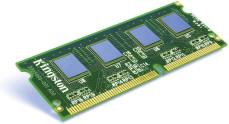
(See related pages)
RAM The amount of RAM is one of the two most important factors (the other one is the CPU) to consider when judging the power of a computer. RAM, or memory, is where all the software you're currently using resides. In fact, even programs you're not explicitly aware of, like the operating system, reside in RAM. So, if you like to have several programs open at once (multitasking), or want to download large complex files like those with and animation, you'll need plenty of RAM. You can check your RAM usage in Windows 2000 and XP by pressing Ctrl-Alt-Del, then click on Task Manager, and choose the Performance tab. When you do this you can see how much RAM you're currently using and also a graph of previous usage. If you want to see how much RAM each process is using you can click on the Processes tab. The two most common types of RAM in computers sold today are Rambus and DDR SDRAM. Of these, DDR SDRAM is the most common. Rambus tends to be more expensive. To save space, the RAM that goes into a notebook is shorter than the equivalent desktop module. These modules will be designated SODIMM as opposed to DIMM for desktops. DIMM stands for dual inline memory module and refers to the physical construction of the memory module. Below are two sites that sell RAM for both desktop and notebook computers.
Crucial DDR 1 GB DIMM
Kingston Notebook SODIMM
|
